Christmas is a time for indulgence, and what better way to spread the holiday cheer than with a traditional German Christmas Cake? Stollen, a beloved Christmas bread hailing from Germany, has been delighting taste buds for centuries. Packed with dried fruits, almonds, and warm spices like cinnamon and nutmeg, German Stollen cake raisin bread is a must-have on every festive table.
My German mom and I have created several delicious Stollen recipes: Chocolate Chip Keto Stollen, Low-Carb Mini Stollen with Almond Flour, Quark Stollen and Poppy Seed Stollen (Mohnstollen).

Table of Contents
- The Perfect German Stollen Cake for Christmas
- What Is German Stollen Cake?
- German Stollen Cake Recipes Come in Many Tasty Versions
- Turn Your German Christmas Cake into Chocolate Chip Stollen
- The History of Germany’s Treasured Stollen Cake Recipe
- Ingredients
- How to Make German Christmas Cake (Weihnachtsstollen)
- FAQs
- Equipment You’ll Need
- How to Store German Christmas Cake (Weihnachtsstollen)
The Perfect German Stollen Cake for Christmas
Are you daunted by the thought of making Stollen? Did it turn out too dry last time you made it? With photos and clear instructions, we explain how to craft the perfect German Stollen cake.
What Is German Stollen Cake?
Stollen, which is also called Weihnachtsstollen (Christmas Stollen) or Christstollen after Christ, is a traditional, spiced, fruit bread made in Germany to celebrate Christmas and the holidays. Known for its soft, rum-soaked raisins, almonds and candied citrus peel, as well as milk, sugar and yeast, bakers also often add a marzipan filling. People give these rich German Christmas cakes to friends and neighbors as gifts and even used to give them to kings.
Also popular: German Plum Cake (Pflaumenkuchen).

German Stollen Cake Recipes Come in Many Tasty Versions
Dresden’s classic raisin Stollen is world famous and available with and without marzipan. There are many other versions of German Christmas cake as well, including Butter Stollen with extra butter, Cherry Stollen with cherries instead of raisins, Poppy Seed Stollen with a poppy seed filling, Quark Stollen made with Quark, a German dairy product, but Greek yogurt works too.
You’ll also find contemporary low carb, keto Stollen recipes such as Chocolate Chip Keto Stollen and Low-Carb Mini Stollen, both made with almond flour.
Trending now: Black Forest Mini Cake.

Turn Your German Christmas Cake into Chocolate Chip Stollen
If you love chocolate-covered biscotti, chocolate-filled croissants, and lemon– or orange-infused chocolate bars, then you MUST TRY chocolate chip Stollen.
Simply make two changes: Use chocolate chips instead of raisins and top the Stollen with a melted chocolate bar instead of powdered sugar.
Or try Sugar Free Plum Cake (German Pflaumenkuchen).

The History of Germany’s Treasured Stollen Cake Recipe
Did Dresden Make the First Stollen?
Dresden is world famous for its Christmas Stollen, but Stollen was actually first mentioned in an official document in Naumburg, Germany. In fact, a Naumburg bakery explains that in 1329 Bishop Heinrich gave Naumburg’s bakers the right to form a bakers guild. In return, the bakers had to pay the bishop and his court two Stollen per year for the Catholic Advent fasting period. So, Stollen was initially a fasting bread. More on this in a moment.
German Stollen Cake Is a Deep-Rooted Tradition in Dresden
Dresden, however, is usually the first name that comes to mind when one thinks of world-famous German Stollen cake. Indeed, its roots run deep, since Dresden’s Christstollen dates back to 1474 which is when it was mentioned in a hospital bill and listed as fasting food made of flour, yeast and water.
Stollen Initially Wasn’t the German Christmas Cake We Know Today
So, the first Stollen recipe was very bland. After all, it was made during Advent which, in Catholic Germany, was a time of fasting and abstinence from meat, so you weren’t allowed to use animal byproducts like butter. So, bakers instead used oil which was expensive and hard to come by.
In 15th century medieval Saxony, the prince decided he wanted to use butter since oil was pricey. He also wanted a tastier holiday bread. So, he wrote to the Pope in 1450 and asked if bakers could add butter to the Stollen recipe. The Pope responded with a firm no. But five Popes later in 1490, Pope Innocent VIII sent the famous “butter letter” to the prince, giving the Prince permission to use butter in Stollen but only for himself, his family and his household.
The Pope added that anyone could use butter as long as they made an annual contribution to support the building of Freiberg’s Minster Cathedral.
Then, in the 16th century, the butter ban was lifted when Saxony became Protestant.
So, the Stollen recipe developed over the centuries from a simple, flavorless Advent bread for the Catholic fasting period to the sweeter Christmas fruit bread we know today.
Trending now: Healthy Chocolate Chip Pecan Pie.
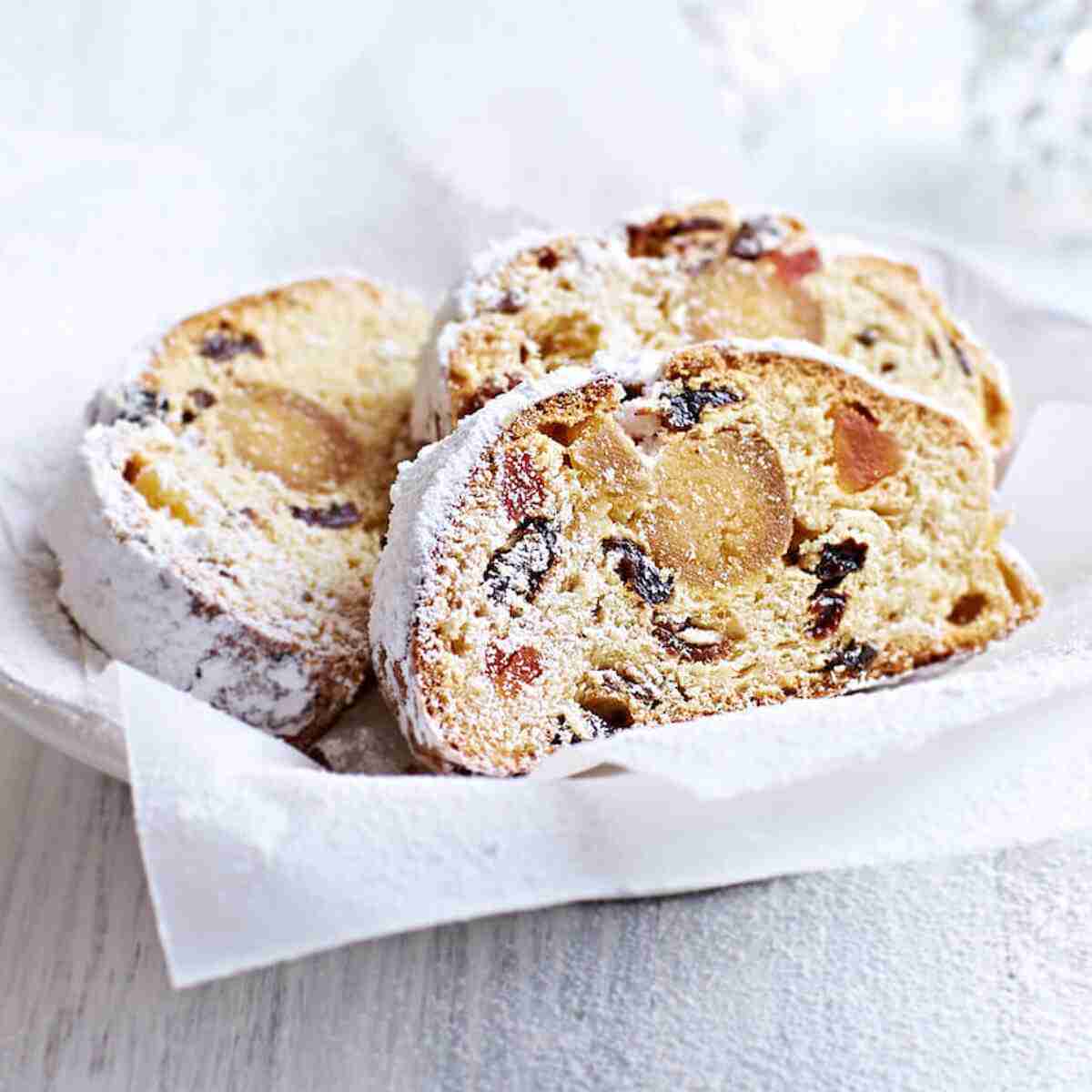
Stollen’s Shape Symbolizes Baby Jesus
Although there are a few different ways to roll and fold Christmas Stollen, the shape has essentially remained the same throughout the ages. The powdery white oval is said to symbolize baby Jesus wrapped in white swaddling clothes.
Ingredients
Optional Marzipan Filling
German Christmas cake tastes great with or without marzipan.
- Marzipan (optional) – store bought or make my easy marzipan recipe which even has a sugar free option.
The Raisin Mixture
- Candied lemon and orange peel – store bought or make it in advance from scratch.
- Raisins – or a mixture of raisins and golden raisins (sultanas).
- Almonds – blanched and sliced. To blanch almonds, put them in boiling water for 1–2 minutes. Then, drain, pinch off the skin and slice.
- Dark rum, fresh-squeezed orange juice or water – softs the raisins.
The Yeast Mixture
- Active dry yeast
- Milk – Use whole milk, since the dough needs the fat.
- Sugar
The Stollen Dough
If you have a kitchen scale, use the gram measurement provided in the Recipe Card below for the flour, so you don’t use too much flour which can dry out your German Stollen Cake.
- All-purpose flour
- Sugar or granulated sweetener of choice – Stollen dough traditionally doesn’t contain a lot of sugar, but you can still reduce the cake’s calories by using a zero-calorie sugar substitute such as monk fruit.
- Salt
- Cinnamon – Use level spoonfuls of the spices.
- Cardamom
- Mace or nutmeg – Dresden Stollen is made with mace, but nutmeg also tastes great. Mace and nutmeg are, in fact, both derived from the fruit of the nutmeg tree: mace from the seed’s crimson covering and nutmeg from the seed.
- Unsalted butter
- Egg
- Vanilla extract
- Lemon zest
Topping and Decoration
- Butter – to brush on the baked cake.
- Powdered sugar – to sprinkle on the buttery, baked Quark Stollen. For fewer calories, opt for a zero-calorie powdered sugar substitute such as powdered monk fruit.
How to Make German Christmas Cake (Weihnachtsstollen)
The instructions explain how to make Stollen with and without marzipan.
The photos below illustrate the process for one Stollen. However, we always double the recipe and make two at a time, since it’s a lot of work and you can always freeze one.
Make the Dough
Check out this charming short film by the Dresden Stollen company. You can watch how the German bakers kneed and shape the dough.
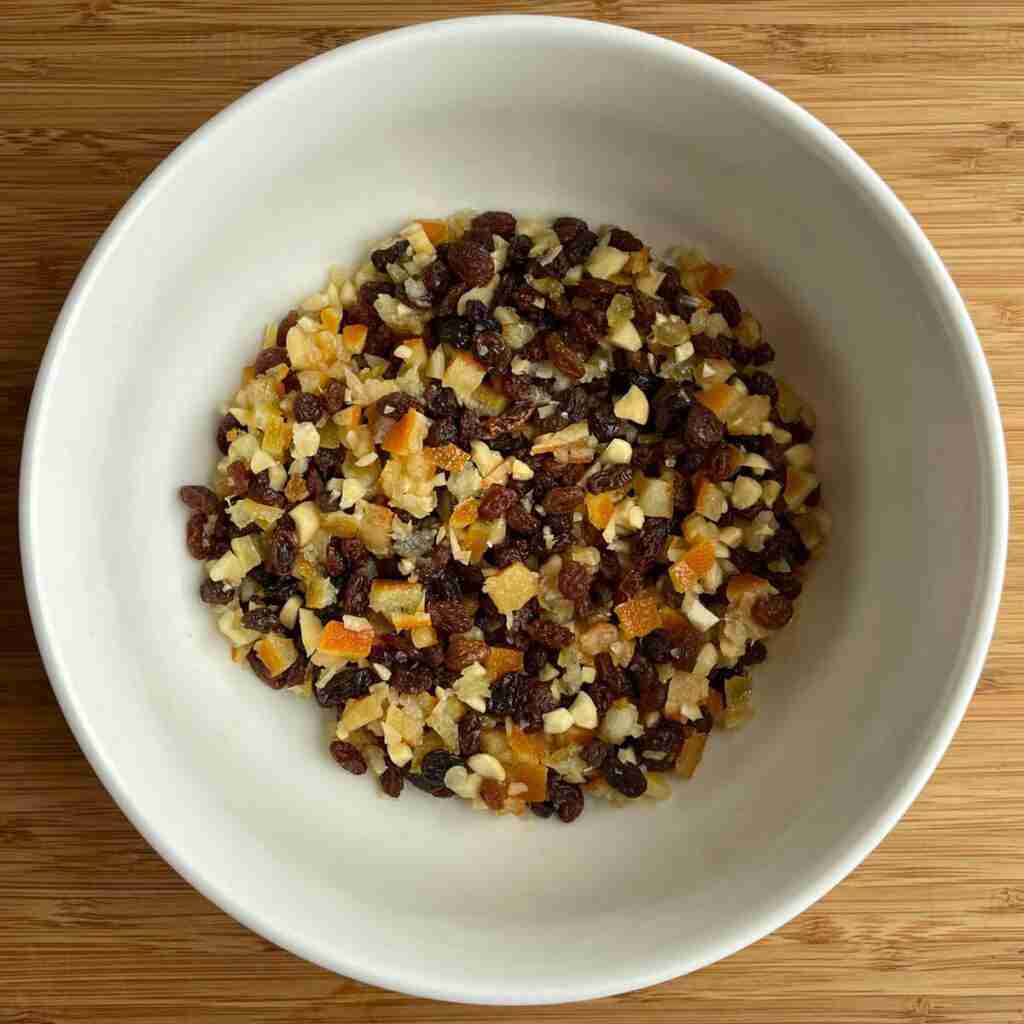
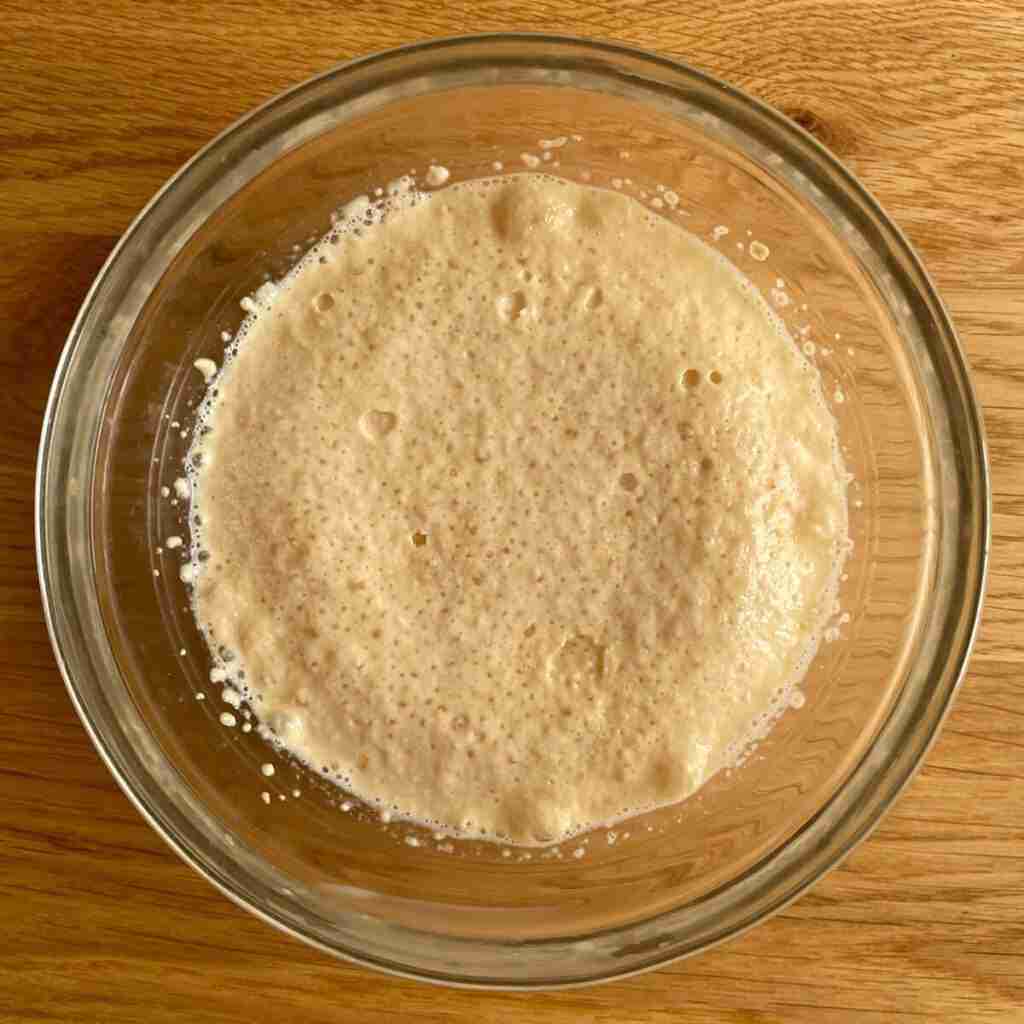
1. Marinate raisins, candied citrus peel and blanched sliced almonds in dark rum or water for at least an hour or overnight. Overnight is the best way to ensure that all liquid is absorbed.
2. Mix the yeast, warm milk and sugar in a small bowl until it has a foamy head. Be sure to use warm milk, so the yeast mixture foams up quickly. Usually 10-15 minutes.
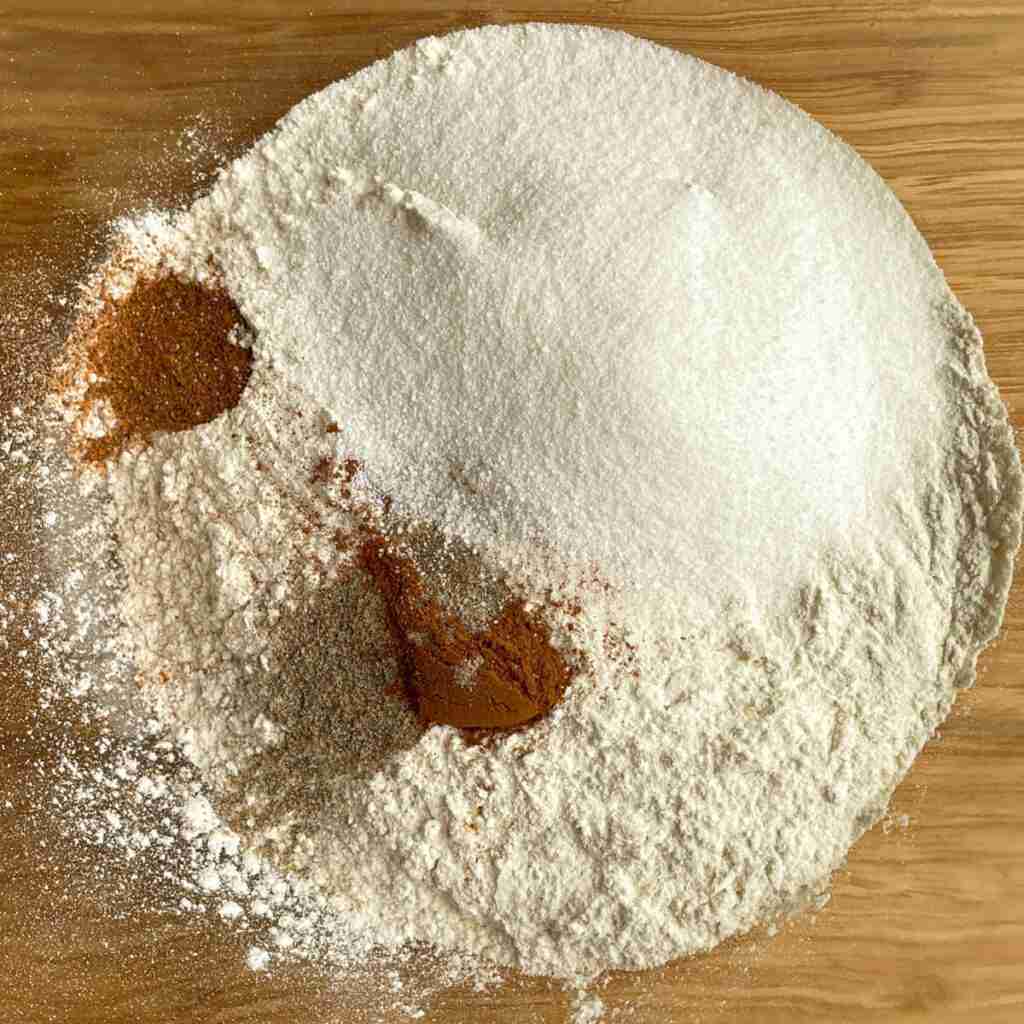
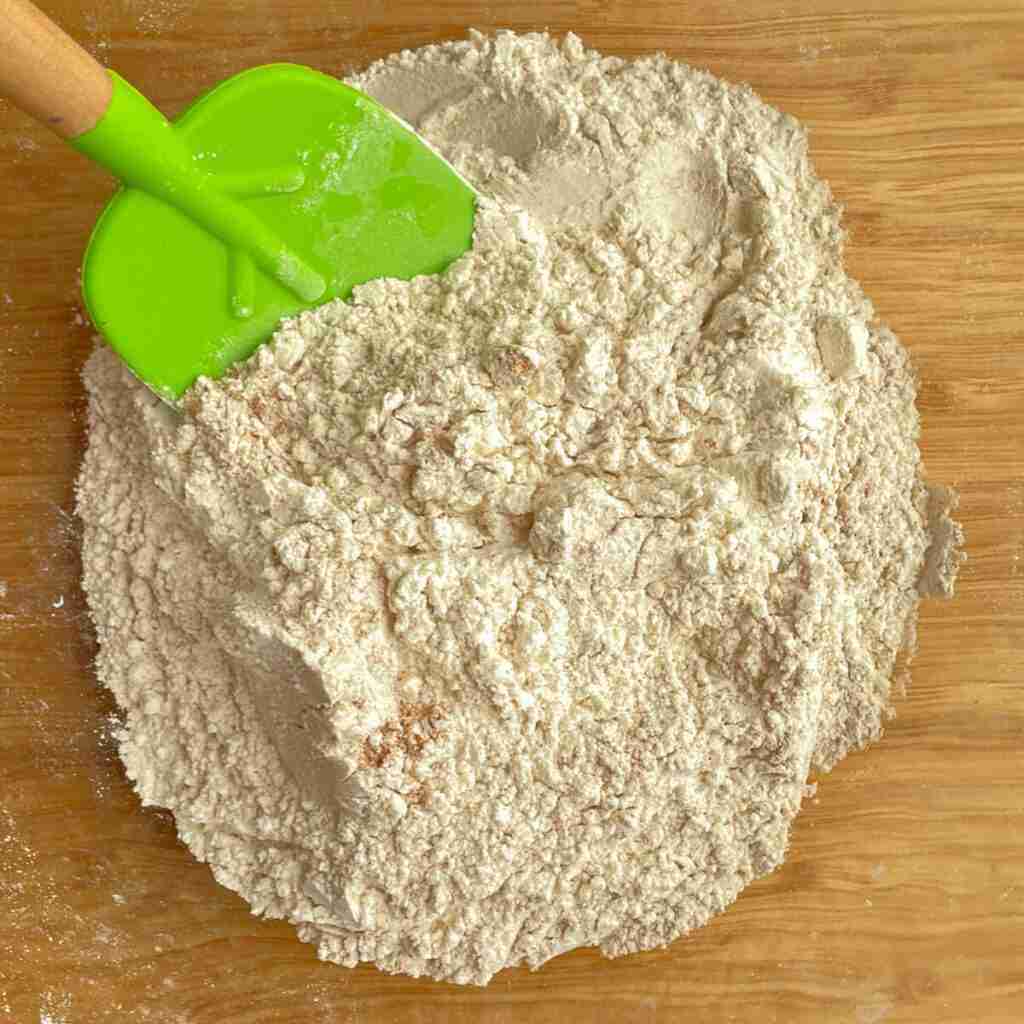
3. Combine flour, sugar (or a zero-calorie sugar replacement such as monk fruit), salt, cinnamon, cardamom and nutmeg or mace in a large mixing bowl.
4. Mix the ingredients to make German Christmas Cake.
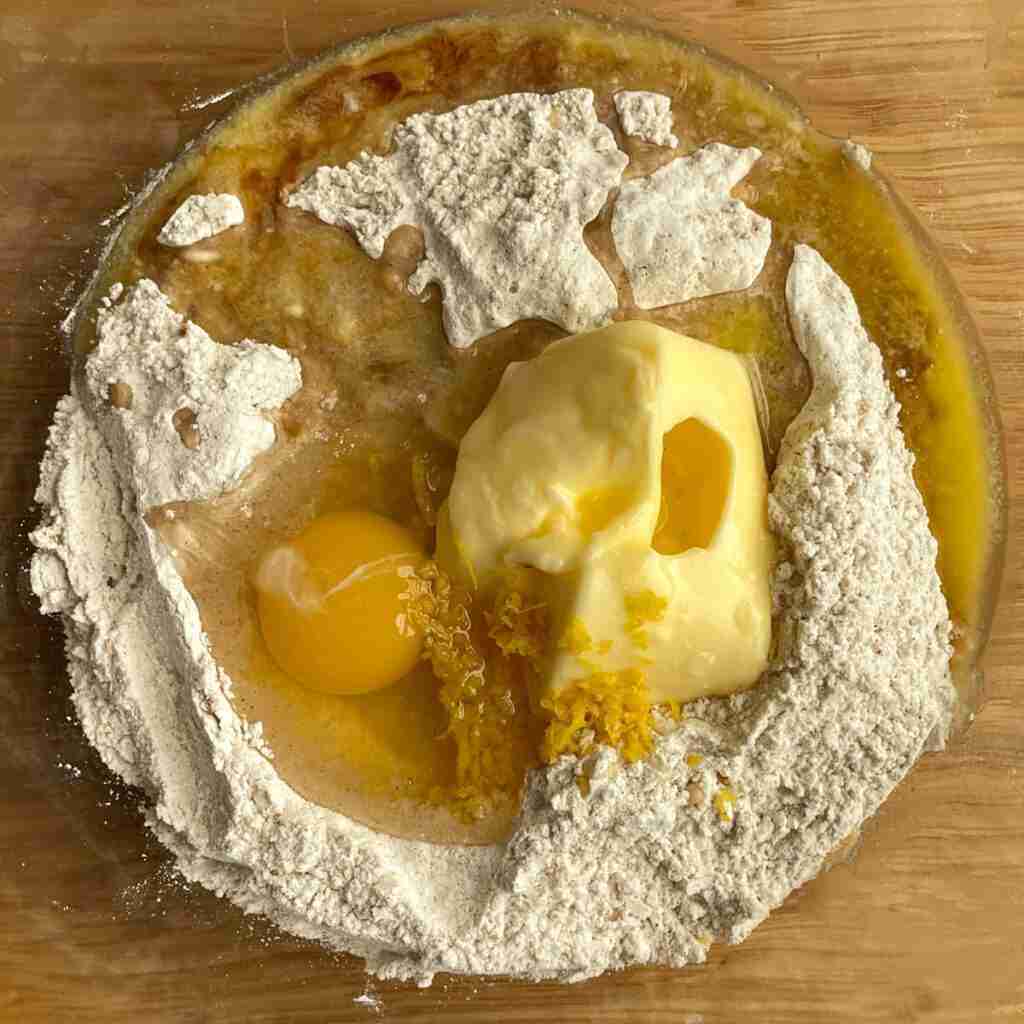
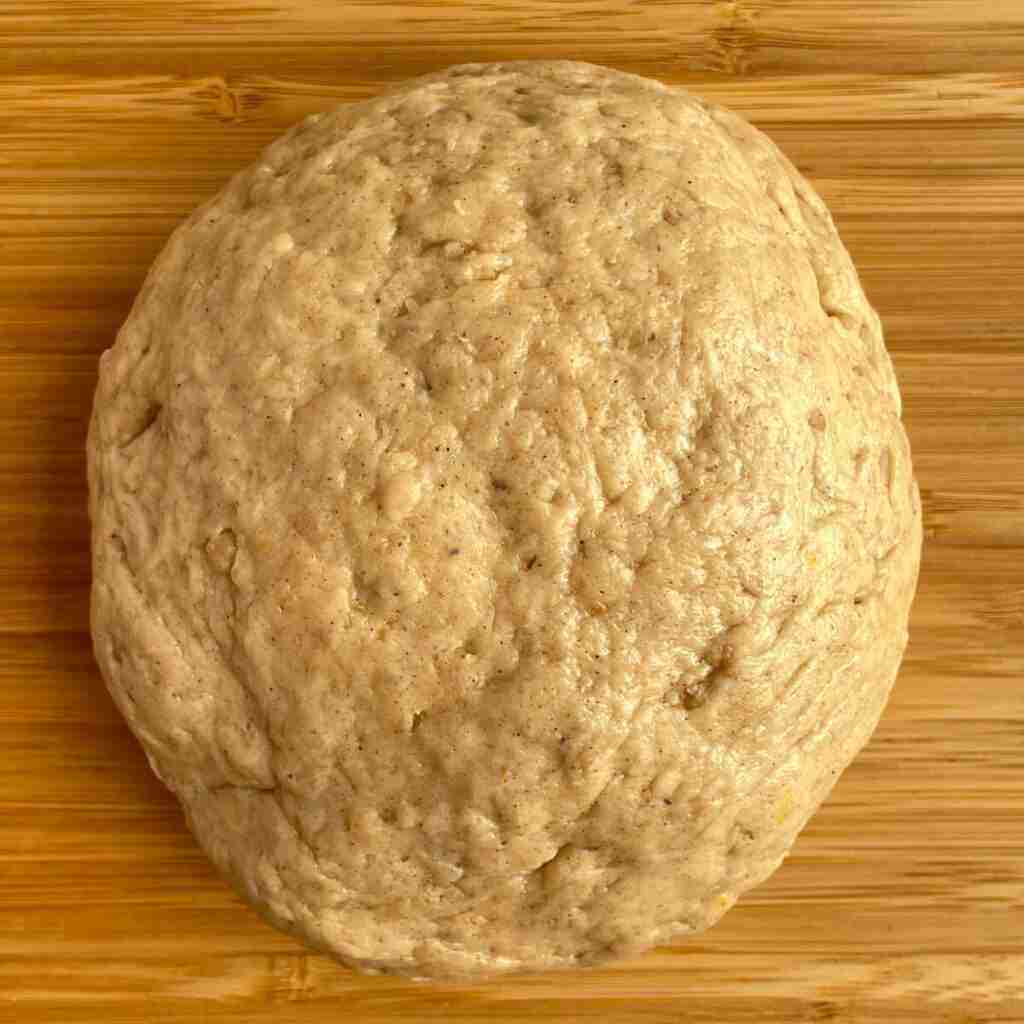
5. Add melted butter, egg, vanilla, lemon zest, and the yeast mixture.
6. Mix dough in a stand mixer with dough hook. The dough should quickly and easily come together on the hook. I don’t add extra flour.
If, for some reason (i.e., humidity), the dough is sticky and doesn’t form a ball, turn it out onto a lightly floured surface. Slowly sprinkle light amounts of flour, one light handful at a time, into the sticky areas and kneed it manually for 1-2 minutes. Then, form into a ball. Note: Be careful that you don’t add too much flour. If you add too much, you will dry out the bread and alter the flavor profile.
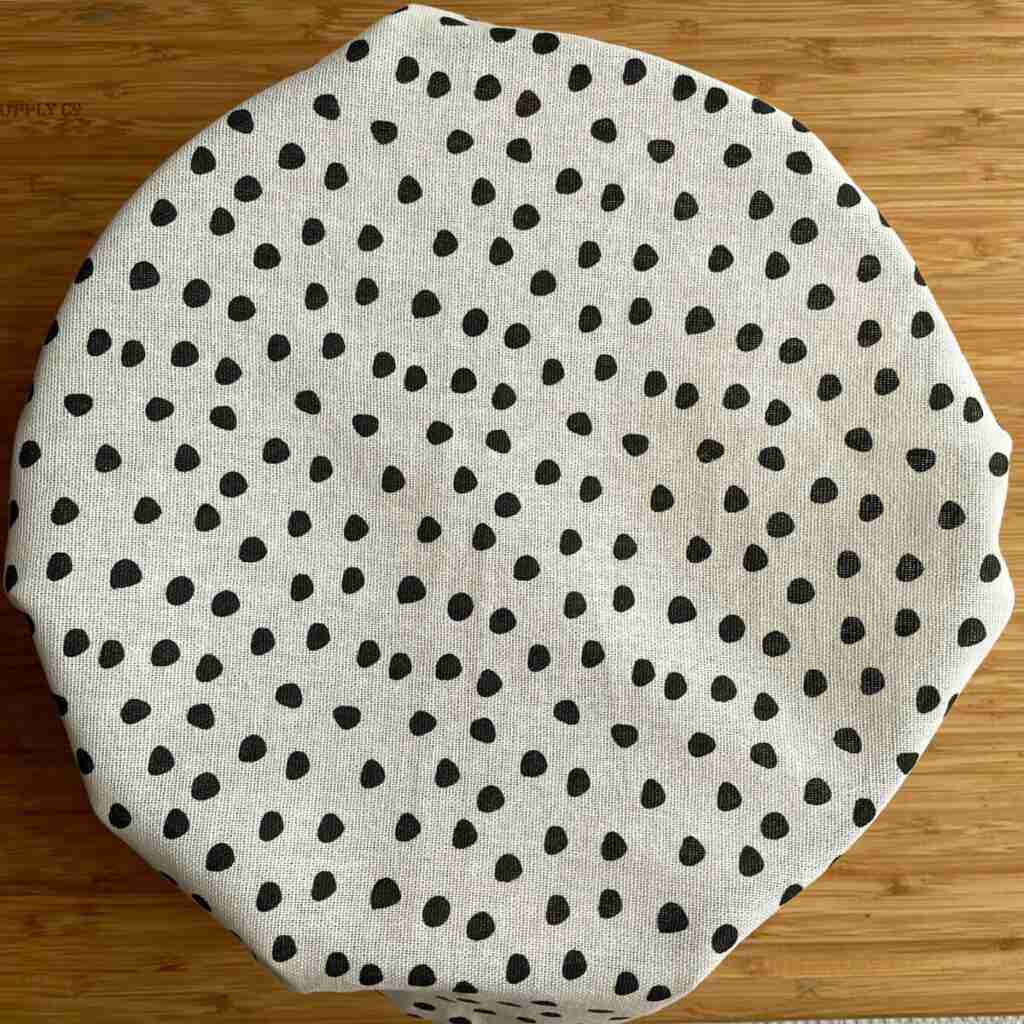

7. Brush your bowl lightly with a flavorless oil (about a teaspoon). Put the dough ball in the bowl and cover with a kitchen towel. Let it rise in a warm place until it has doubled in size. Usually 1–2 hours.
8. There shouldn’t be any extra liquid in the raisin mixture but if there is, drain it, so the dough doesn’t get too sticky. Then mix the raisin mixture into the dough by hand or spatula. Since the raisin mixture is a little moist, the dough might feel a tiny bit sticky. Just keep shaping it and kneading it in your hands or in the bowl until it forms a ball. The more you work it, the less sticky it gets. We usually don’t add flour at this point. But if you feel you have to, sprinkle in a small amount by hand and shape the dough some more before adding more flour. If you add too much flour, you could dry out your German Stollen Cake.
Shape German Christmas Stollen Cake

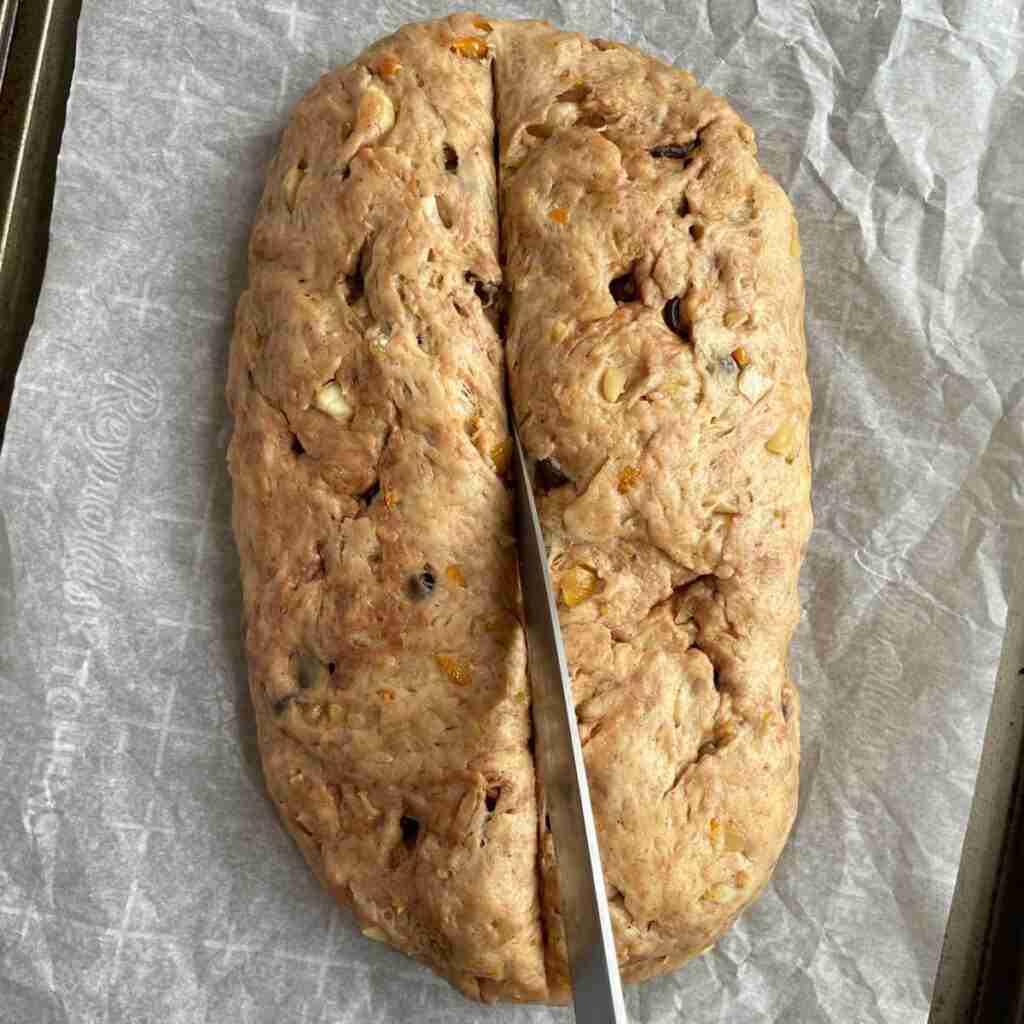
9. Put the dough ball on your unfloured work surface. To ensure that the raisins are mixed in properly, kneed the dough for about 2 minutes. In other words, push the dough away from you with the heels of your palms, folding it over itself with your fingers, and then pulling it back.
10. If you’re adding marzipan, shape the dough into an oval and skip to the next section that explains how to add marzipan. Otherwise, slice the oval-shaped dough lengthwise about an inch deep to give it the characteristic Stollen look.
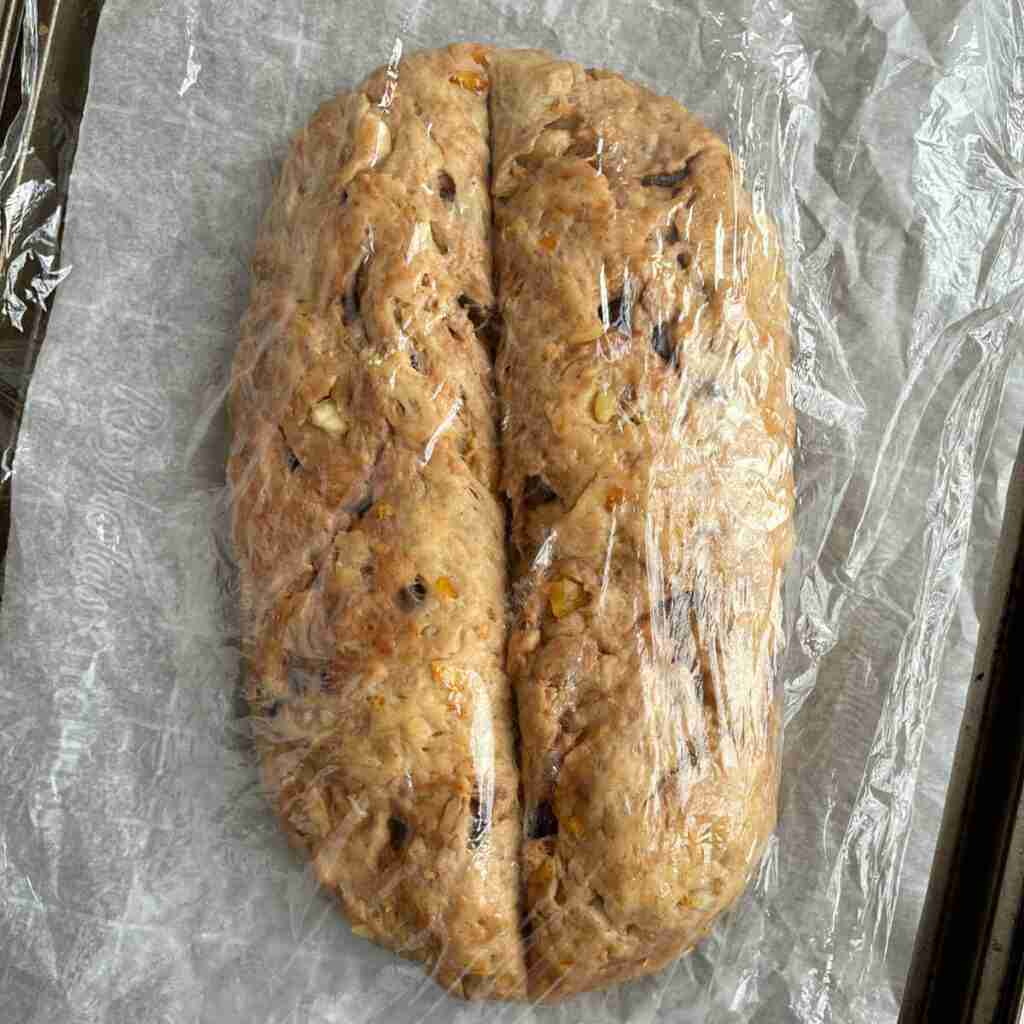

11. Lightly cover with plastic wrap and let it rise for another hour. It will get a bit bigger but won’t double in size.
12. Before baking, press any exposed raisins into the dough. Otherwise, they will burn. Then, bake at 350F for 30-35 minutes until golden brown. Pictured on the left is a baked marzipan Stollen with the traditional hump and on the right a baked raisin Stollen.
Add Marzipan to Make Marzipan Stollen

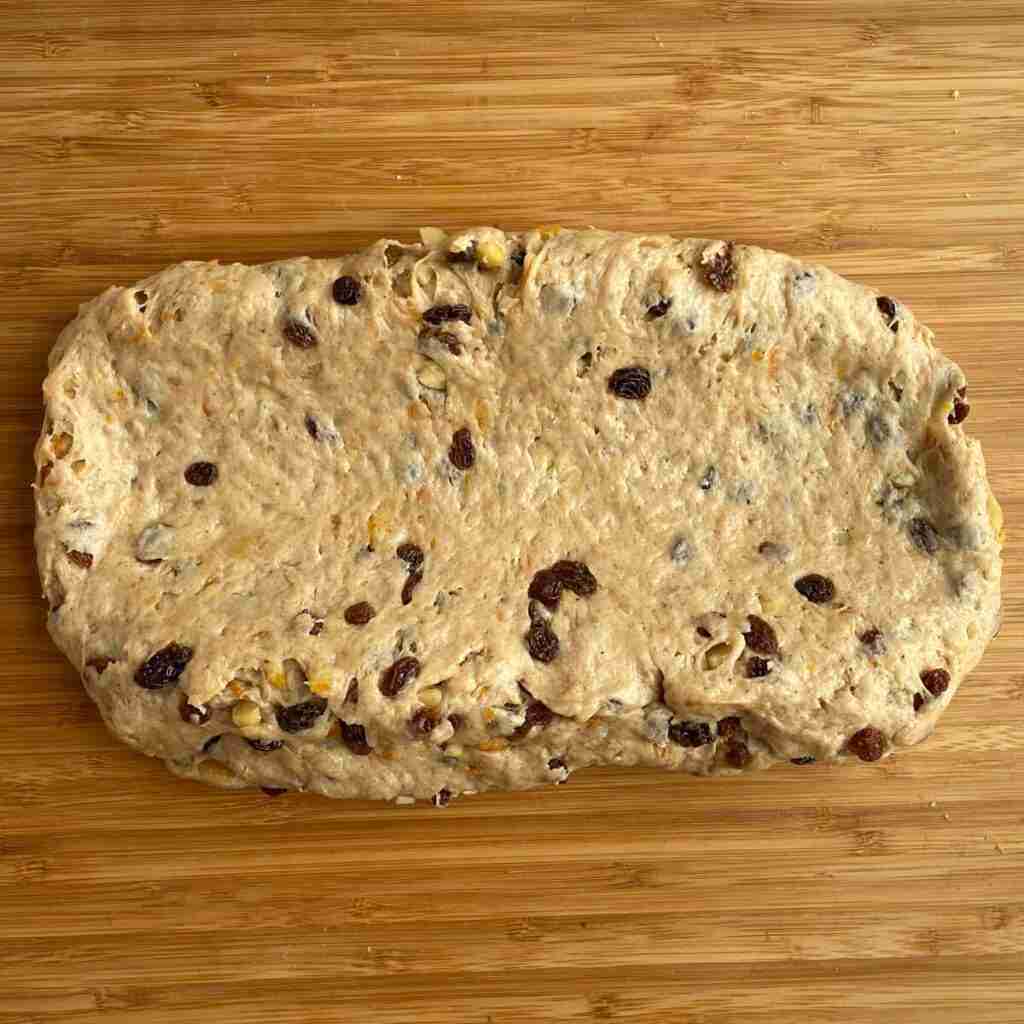
1. Press down with your rolling pin to form a channel in your German Christmas bread.
2. Roll the pin a bit to widen the channel. The dough on the side closest to you should be a bit thicker and taller.


3. Put the marzipan in the channel.
4. Fold the side furthest from you over the marzipan.


5. The dough should look like this.
6. With your rolling pin, press down to seal the German Christmas Cake.


7. Shape the hump by hand and place on parchment sheet.
8. Cover lightly with plastic wrap and let it rise for another hour. Your German Christmas cake will get a bit bigger but won’t double in size. Before popping it into the oven, press any exposed raisins into the dough. Otherwise, they will burn. Then, bake at 350F for 30-35 minutes until golden brown.
Butter and Decorate Baked German Stollen Cake


1. When the Stollen comes out of the oven, immediately use a skewer or toothpick to poke holes in the Stollen. This will help the Stollen absorb the butter.
2. Then, brush 3–4 tablespoons of melted butter on each hot Stollen cake.


3. Then immediately sift powdered sugar on the Stollen, tapping the sugar with a spoon as you generously coat the hot, buttered Stollen. If calories are a concern, use a zero-calorie sugar replacement such as powdered monk fruit.
4. Let the German Christmas Cake fully cool and enjoy.
FAQs
Firstly, use a natural, zero-calorie, zero-carb sugar replacement such as monk fruit to reduce the carbs and calories. Secondly, since raisins are high in sugar and carbs, you can omit them or reduce the amount you use and instead add a few more blanched, sliced almonds. So, eliminating caloric refined sugar and adding more low carb almonds will help make your German Christmas Cake more diabetic-friendly.
Simply use a natural sugar replacement such as zero-calorie, zero-carb monk fruit which doesn’t have an aftertaste.
In Germany, the Stollen or Christstollen season runs from November 1 to December 31. You can, of course, enjoy homemade German Stollen bread throughout the year.
No, it doesn’t taste alcoholic at all. The rum softs the raisins, almonds, and candied citrus peel and helps preserve the German Stollen cake.
Equipment You’ll Need
- A stand mixer with dough hook
- A spatula
- A baking sheet
- Parchment paper
- A sieve – to sift the powdered sugar on the Stollen
How to Store German Christmas Cake (Weihnachtsstollen)
To store: Store in an airtight bag or container in a cool place for a few days or in the refrigerator for up to a week.
To freeze: You can also freeze German Stollen bread in a sealed bag or container for up to 3 months.
DID YOU MAKE THIS GERMAN CHRISTMAS CAKE RECIPE?
I’d love to hear your feedback. Please leave a comment/star rating ⭐️⭐️⭐️⭐️⭐️ below. And, of course, please share the recipe. You can also FOLLOW ME on INSTAGRAM, FACEBOOK and PINTEREST for healthy dessert and snack recipes!
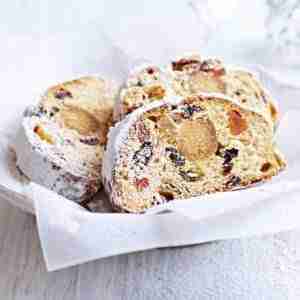
German Christmas Cake: How to Make Authentic German Stollen Cake
Equipment
- 1 Stand Mixer with Dough Hook
- 1 Spatula
- 1 or 2 Baking Sheet(s) depending on how many Stollen you are making.
- parchment paper
- 1 sieve to sprinkle the powdered sugar on the baked Stollen.
Ingredients
Marzipan filling (optional)
- 4 ounces Marzipan per Stollen cake Store bought or try my 5-minute marzipan recipe which provides enough marzipan for 2 Stollen. You can make this in advance and freeze it until you are ready to use it.
Raisin Mixture – Marinate at least an hour but make the day before if you can.
- 3 ounces Candied Lemon & Orange Peel (equal portions of both) Store bought or make homemade candied citrus peel recipe which takes 2-3 days to dry if you don't have a dehydrator.
- 4½ ounces Raisins Or a mixture of regular and golden raisins.
- 1½ ounces Blanched, Chopped Almonds To blanch, put the almonds in boiling water for 1-2 minutes. Then pinch off the skin and slice.
- 3 tablespoons Dark Rum. Fresh-Squeezed Orange Juice or Water
The Yeast Mixture
- 1½ teaspoons Active Dry Yeast
- ½ cup Warm Whole Milk Be sure to use warm milk, so the yeast mixture foams up quickly.
- 1 tablespoon Sugar
The Dough
- 2⅓ cups All-Purpose Flour For one Stollen, this is 325 grams.
- 4 tablespoons Sugar or sugar replacement such as monk fruit
- ½ teaspoon Salt
- ½ tablespoon Cinnamon Use level spoonfuls of the spices.
- ½ teaspoon Cardamom
- ½ teaspoon Nutmeg or Mace
- ½ cup Unsalted Butter, soft
- 1 Egg
- 1 teaspoon Vanilla Extract
- 1 teaspoon Lemon Zest
Butter & Decorate the Stollen
- ½ cup Unsalted Butter to generously brush on the Stollen.
- Powdered Sugar or a powdered sugar substitute to coat the baked Stollen.
Instructions
Candied Orange and Lemon Peels
- Make homemade candied citrus peels for the raisin mixture a few days in advance if you aren't using store-bought candied lemon and orange peels. Homemade does, however, take 2–3 days to dry if you don't have a dehydrator.
Marzipan
- If you plan to add the marzipan filling and aren't using store-bought marzipan, make homemade marzipan which is a fast, 5-minute recipe. You can make it in advance and freeze it until you are ready to use it.
Make the Raisin Mixture the night before, if possible
- Put the diced candied citrus peels, raisins, and chopped blanched almonds in a bowl. Add the dark rum, fresh-squeezed orange juice or water at least an hour before you plan to use the mixture. For best results, marinate overnight so all the liquid is absorbed.
Make the Yeast Mixture
- Put the yeast in a small bowl. Add the warm milk and sugar. Wait until the mixture has a foamy head. Be sure to use warm milk, so the yeast mixture foams up quickly. Usually 10-15 minutes.
Make the Dough – Photos of the entire process are provided above in the post.
- In a large mixing bowl, combine the flour, sugar, salt, cinnamon, cardamom, nutmeg or mace.
- Add the softened butter, egg, vanilla, lemon zest and yeast mixture.
- Mix dough in a stand mixer with dough hook. The dough should quickly and easily come together on the hook. I don't add extra flour. If, for some reason (i.e., humidity), the dough is sticky and doesn't form a ball, turn it out onto a lightly floured surface. Slowly sprinkle light amounts of flour, one light handful at a time, into the sticky areas and kneed it manually for 1-2 minutes. Then, form into a ball. Note: Be careful that you don't add too much flour. If you add too much, you will dry out the bread and alter the flavor profile.
- Brush your bowl lightly with a flavorless oil (about a teaspoon). Put the dough ball in the bowl and cover with a kitchen towel and let it rise in a warm place until it has doubled in size. Usually 1–2 hours.
Add the Raisin Mixture
- There shouldn't be any extra liquid in the raisin mixture but if there is, drain it, so the dough doesn't get too sticky. Then mix the raisin mixture into the dough by hand or spatula. Since the raisin mixture is a little moist, the dough might feel a tiny bit sticky. Just keep shaping it and kneeding it in your hands or in the bowl until it forms a ball. The more you work it, the less sticky it gets. We usually don't add flour at this point. But if you feel you have to, sprinkle in a small amount by hand and shape the dough some more before adding more flour. If you add too much flour, you could dry out the Stollen.
- Put the dough ball on your unfloured work surface. To ensure that the raisins are mixed in properly, kneed the dough for about 2 minutes.
- IF YOU'RE ADDING MARZIPAN: Shape the dough into an oval. See the section in the post with photos explaining how to add marzipan. IF YOU AREN'T ADDING MARZIPAN: Shape the dough into an oval. Then, use a knife and slice the top of the dough lengthwise about an inch deep to give it the traditional Stollen look. You'll find photos in the post.
- Lightly cover with plastic wrap and let it rise for another hour. It will get a bit bigger but won't double in size.
- Before baking, press any exposed raisins into the dough. Otherwise, they will burn. Then, bake at 350 F for 30-35 minutes until golden brown.
How to Butter & Decorate Baked Stollen
- When the Stollen comes out of the oven, immediately use a skewer or toothpick to poke holes in the Stollen. This will help the Stollen absorb the butter.
- Immediately brush 3–4 tablespoons of melted butter on each hot Stollen.
- Then immediately sift powdered sugar on the Stollen, tapping the sugar with a spoon as you generously coat the hot, buttered Stollen.
- Let it cool and enjoy.
Notes
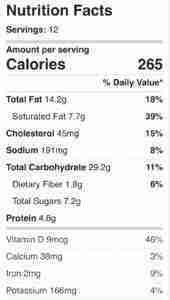
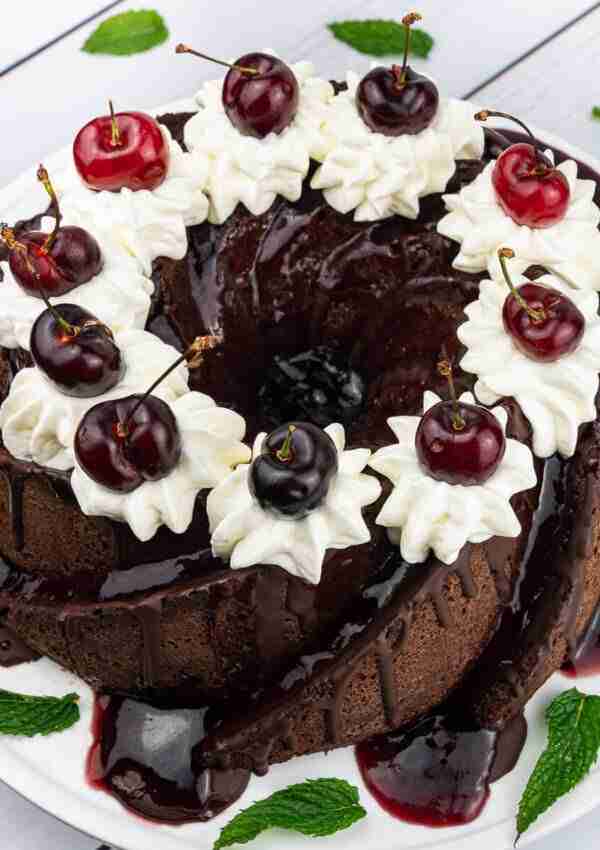

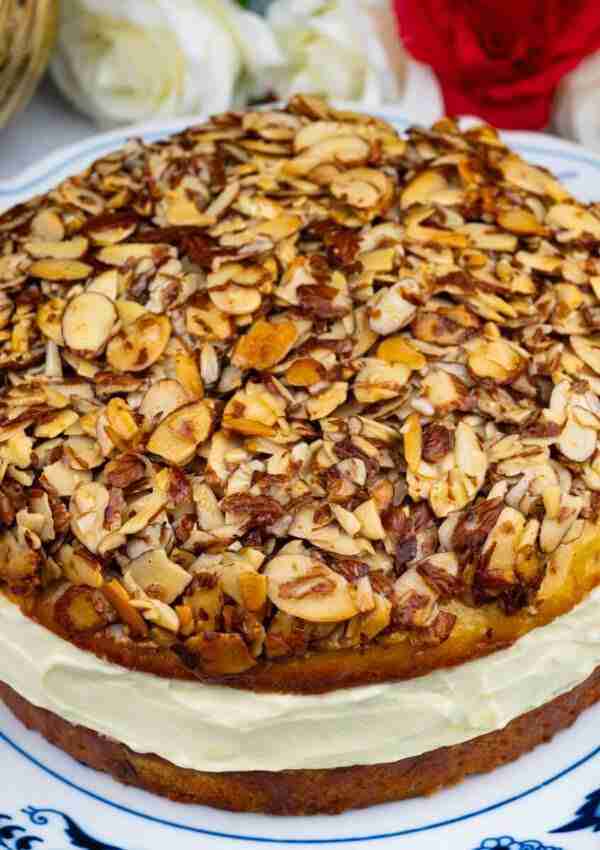
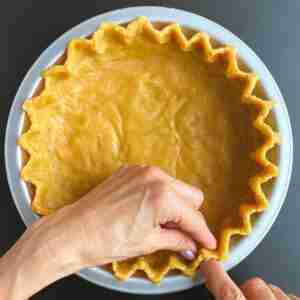


I really loved the chocolate chip stollen cake. I made it with dark chocolate chips, and it was really chocolaty. I am glad I made it and will certainly bake it again.
Thanks for letting me know. I always love making it too.